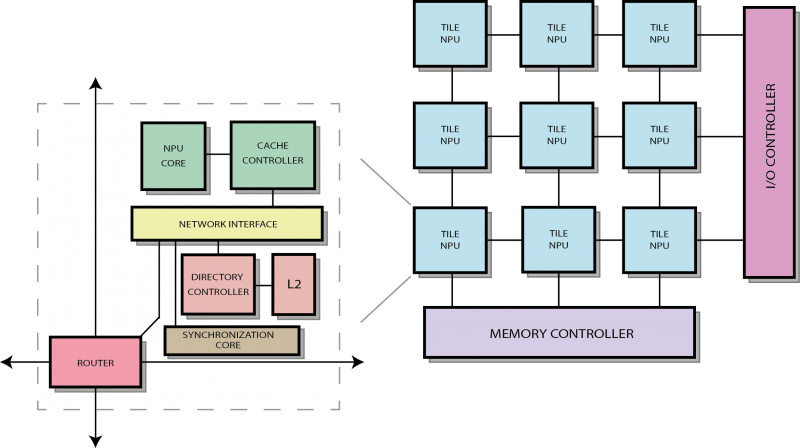The NaplesPU Hardware architecture
TODO: aggiungere riferimento alla configurazione single core
The nu+ manycore is a parametrizable regular mesh Network on Chip (NoC) of configurable tile, developed by CeRICT in the framework of the MANGO FETHPC project. The main objective of nu+ is to enable resource-efficient HPC based on special-purpose customized hardware. Our aim is to build an application-driven architecture to achieve the best hardware/software configuration for any data-parallel kernel. Specialized data-parallel accelerators have been known to provide higher efficiency than general-purpose processors for codes with significant amounts of regular data-level parallelism (DLP). However every parallel kernel has its own ideal configuration.
Each nu+ tile has the same basic components, it provides a configurable GPU-like open-source soft-core meant to be used as a configurable FPGA overlay. This HPC-oriented accelerator merges the SIMT paradigm with vector processor model. Furthermore, each tile has a Cache Controller and a Directory Controller, those components handle data coherence between different cores in different tiles.
User design can set an high number of parameter for every need, such as:
- NoC topology and Tile number.
- Threads per core number. Each thread has a different PC, so one core can executes as many program as many threads it has.
- Hardware lanes per thread. Each thread can be a vector operation (here called hardware lane).
- Register file size (scalar and vector).
- L1 and L2 cache size and way number.
There are all the hardware main section. Each of them covers important aspects of the hardware.
Hardware features
TODO: descrivere tutte le feature offerte dal core (thread, lanes, scratchpad, sincronizzazione, interfaccia di IO), la cui implementazione e' dettagliata poi nella pagina Core architecture o nelle pagine specifiche
The system is based on a 2D mesh of heterogeneous tiles relying on a network-on-chip (NoC). The NoC routers are tightly coupled with network interface modules providing packet-based communication over four different virtual channels. A two-stage look-ahead router is used implementing a wormhole flit-based communication. The networking infrastructure allows both intra-tile and inter-tile communication. One virtual channel is dedicated to service message flows. In particular, the manycore system supports a distributed synchronization mechanism based on hardware barriers. Importantly, based on simple valid/ready interfaces, one can integrate any processing unit in each tile.
The GPU-like provided within the manycore is highly parameterizable, featuring a lightweight control infrastructure, hardware multithreading as well as a vector instruction set targeted at data-parallel kernels. In particular, the core is organized in 16 processing elements (PEs), each capable of both integer and floating-point operations on independent data, providing SIMD parallelism. Correspondingly, each thread is equipped with a vector register file, where each register can store up to 16 scalar data allowing each thread to perform vector operations on 16 independent data simultaneously.
Hardware sections
Include:
Common:
Single Core:
- TODO Cache Controller
Many Core:
Deploy:
- TODO System interface descrizione dettagliata interfaccia item (comandi, console) e memoria
- TODO System deployment descrizione uart_router, memory_controller, con riferimento a template nexys4ddr
Testbench:
